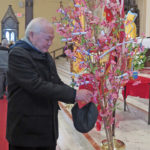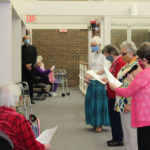By Sarah Callahan
Gray Space Graces

In my introductory article to this column, I laid out my vision for Gray Space Graces. In that article I shared, “In a world that seems more polarized than ever, how can we engage with one another in a constructive way? How can we better understand and be better understood? Jesus tells us that he came so that we may have life and have it more abundantly (John 10:10). How can we accept and live the abundant lives that Jesus so deeply desires to give us?”
In this column, I continue to draw on and come back to the idea of wrestling and resting in the gray space, the tension, the in-between, the liminal space. The other day I came across a pertinent example of doing so. I’m currently reading the book, “We Survived the End of the World: Lessons from Native America on Apocalypse and Hope.” In this text Charleston, the author and Choctaw elder, points out that the world around us can make us feel afraid with its natural disasters, pandemics, polarization, corruption and more. He explores how we, in America today, can learn from indigenous people and their survival of oppression and the attempt of erasure against them. Charleston does this by surveying four different indigenous prophets.
The author describes the role of prophet as one who helps their people “live through apocalypse with courage and dignity.” Prophets serve as a warning system to a culture at risk, as a herald of vision for what is ahead, as teachers who show people the way to end suffering and derail the course of destruction, and as mystics who walk with people. The prophet’s aim is to “stand on solid ground, even while the earth beneath their feet is moving,” the author continues, “prophets are immersed in tradition even as they talk about how that tradition will need to change to meet new apocalyptic challenges.”
This vision of a prophet struck me. It seems to me that with this definition, a prophet could also be understood as one who wrestles and rests in the gray space, one who isn’t afraid to hold tension. Isn’t this what each of us is called to do as followers of Jesus in the 21st century? To draw from our deep well of tradition while also allowing the tradition to be a dynamic, living and breathing thing that speaks into and out from our point and time in history?
Speaking from personal experience, I have often felt as if polarization and our inability to speak tenderly to and take seriously those across the political and ideological aisle from us obliterates any potential for real encounter, connection and Christ-like fraternity. I have been discouraged deeply by conversations in which I feel that my point of view has been discounted and my voice spoken over, but I have also been disappointed by my lack of charitable listening and tender discourse in these same situations.
What gives me hope is the many prophets that we can look to as role models. Those whom we have witnessed and heard stories about, who hold the sacred tension and walk the narrow ridge, those who prioritize the connection of people and communities over the need to prove a point. Those who demand that hope has the last word.
I am reminded of the prophets Charleston uses as exemplars in his text, such as Ganiodaiio of the Seneca, who due to his role as prophet, “was both lauded and despised,” by those of all different convictions and “he stood in the midst of this controversy,” in the gray space. In doing so, he, “succeeded in preserving the very traditions he was reforming.”
Who are the prophets that we notice in our day and age? Who is it that locates themselves in the midst of controversy in order to wrestle with the sacred tension? Who is it around us that stands on solid ground, even when the earth beneath them is moving? May each of us become those people and prophets of our age. Let us pray that we can be warning systems and heralds of vision, that we can serve as teachers and mystics, standing with and guiding our human family to hope.
(Sarah Callahan is social media coordinator for the Diocese of Davenport.)











